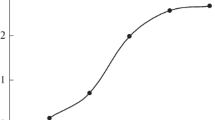Summary
A comparative study has been made of the use of silver iodate, mercurous iodate and mercuric iodate for the determination of the chloride ion on the micro scale. The principle of the method is that the sparingly-soluble iodate reacts with the chloride ion to produce an equivalent amount of iodate ion. After filtration of the solution the iodate ion is titrated iodometrically, a six-fold amplification of titre being obtained.
All three of the reagents give results of similar accuracy. Mercuric iodate is slightly superior in this respect to the other two reagents, but has the disadvantage that it cannot be used in acidic solutions. The results obtained are very reproducible, but deviate up to two per cent from the theoretical, depending upon the chloride ion concentration in the range 0.7–3.5 mg.
Zusammenfassung
Es wurden vergleichende Untersuchungen über die Verwendung von Silber-, Quecksilber(I)- und Quecksilber(II)-Jodat zur Mikrobestimmung von Chlorionen durchgeführt. Das Prinzip der Methode beruht auf der geringen Löslichkeit dieser Jodate, die mit Chloridionen unter Bildung äquivalenter Mengen freier Jodationen reagieren. Nach Filtration der Lösung werden diese jodometrisch titriert, wobei sich der sechsfache Titer ergibt.
Alle drei Reagenzien geben Resultate ähnlicher Genauigkeit. Quecksilber(II)-Jodat ist den beiden anderen Salzen etwas überlegen, hat aber den Nachteil, daß es in saurer Lösung nicht verwendbar ist. Die Ergebnisse sind gut reproduzierbar, liegen aber bei Anwendung von 0,7 bis 3,5 mg Chloridionen bis zu 2% über der Theorie.
Résumé
On a fait une étude comparée pour l'emploi de l'iodate d'argent, de l'iodate mercureux et de l'iodate mercurique pour le dosage de l'ion chlorhydrique à l'échelle micro. Le principe de la méthode est que l'iodate peu soluble réagit sur celui-ci pour produire une quantité équivalente d'ion iodique. Après filtration de la solution, ce dernier est dosé iodométriquement, ce qui amplifie le titre de six fois. Ces trois réactifs donnent des précisions du même ordre. L'iodate mercurique est légèrement supérieur aux deux autres à cet égard mais il présente l'inconvénient de ne pouvoir servir en solution acide. Les résultats obtenus sont très reproductibles mais s'écartent de 2% au maximum de la théorie suivant que la concentration en ion chiorhydrique est comprise dans le domaine 0,7–3,5 mg.
Similar content being viewed by others
References
J. F. Alicino, A. Crickenberger andB. Reynolds, Analyt. Chemistry21, 755 (1949).
T. Leipert, Mikrochim. Acta3, 73, 147 (1938).
J. Sendroy Jr., J. Biol. Chem.120, 405 (1937);127, 483 (1939).
G. A. D. Haslewood andE. J. King, Biochem. J.30, 902 (1936).
R. Grangaud, Bull. soc. chim. France10, 236 (1943); Abstr.: Analyst70, 144 (1945).
J. Grodsky, Analyt. Chemistry21, 1551 (1949).
K. Avaliani, Zavodskaya laboratorija12, 179 (1946); Abstr.: Analyst72, 370 (1947).
Author information
Authors and Affiliations
Rights and permissions
About this article
Cite this article
Belcher, R., Goulden, R. The micro-determination of chloride ion using an amplification procedure. Mikrochim Acta 41, 290–297 (1953). https://doi.org/10.1007/BF01624898
Received:
Issue Date:
DOI: https://doi.org/10.1007/BF01624898




